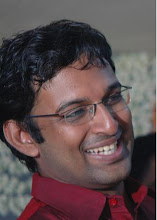I will be working on a new k-Nearest Neighbor based Machine learning approach. The distance metric that will be used in this method will be normalized cross correlation. We will learn over the given synapse examples marked up by the Marc lab as we did in the previous experiments. The experiment set up will be as follows.
Setting up examples
Positive examples: For the few chosen samples synapses, we will try to find out the center of the dark mass of pixels. After finding the center we will rotate the image about that center by 10 degrees and create 35 new samples. Say we chose 50 example synapses, we will have 1750 (35 x 50) positive examples. We rotate the example to come around the rotation variability. The examples regions will be circular in shape again.
Negative examples: Negative examples chosen will be any location that doesn't enclose even part of any synapses.
Running the experimentSub sampling few pixels: Getting to the center of dark regions of the synapses by iterating through all pixels of the image will be a costly operation. So just like the the
previous experiments we will used the SIFT key points filtered by a thresholded CLAHE image. At this point we are assuming we will be able to find center of dark region near the key point. After finding the center point. For the calculated center points, we will find the normalized cross correlation to all the positive and negative examples. Then we will use these distance measurements and run a kNN based classifier.
Verifying Assumption: The primary assumption for the experiment is that we will be able to find the center of the synapse if we are close enough to the synapse. Hence, first we will verify if the assumption is reasonable enough. For that will take the ground truth Synapse markup and extract the region around them and try finding the center. The following algorithm will be used to find out the center of the Synapse:
- For each marked up synapse point extract a circular region around it.
- We will weigh the image by the darkness of the pixels(inversely proportional to pixel intensity), and closeness to the marked up point (inversely proportional to the distance from markup). Hence we will invert the image (255 - Image) and weigh the pixels away from the point by a Gaussian and find the new center for the region.
- Use the new center and repeat step 2 to find new center till it converges.
I guess, if at least 90% of the Synapses converge it would be a reasonable assumption.


















